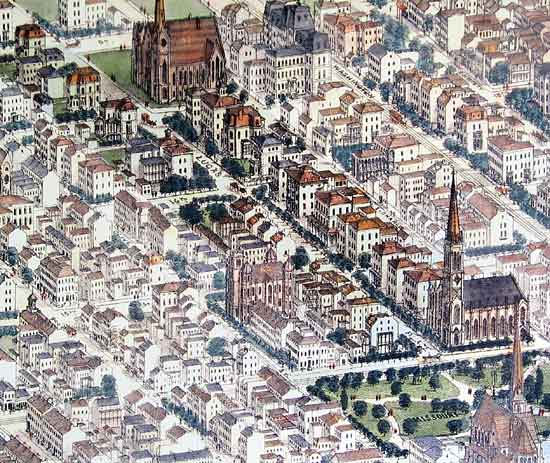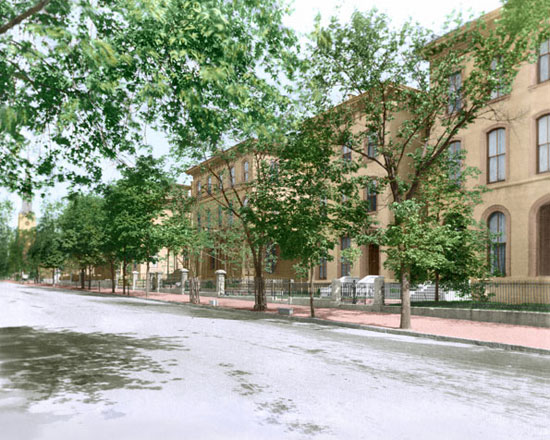
A colorized street level view of Lucas Place, circa 1885.
The building that is today the Campbell House Museum was built in 1851 and was the first home built on Lucas Place. It is now the sole survivor of Lucas Place, St. Louis’ first private neighborhood, and once the city’s social and cultural hub.
Following the cholera epidemic and fire in 1849, wealthy citizens became convinced that it was
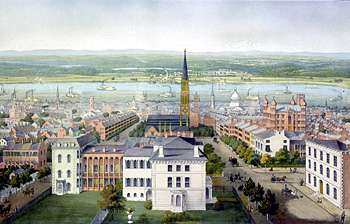
Lucas Place, circa 1865. Looking east towards the levee with the Mississippi River and Illinois in the background.
© Campbell House Foundation 2004
no longer desirable to live in downtown St. Louis. James Lucas and his sister Anne Lucas Hunt soon offered a solution. They developed the idea of the “Place,” a neighborhood with deed restrictions that ensured it remained apart from the city and general population. The main thoroughfare was aptly called Lucas Place. Originally Lucas Place (now Locust Street) extended between 13th and 16th streets when the city limits were just one block to the west between 17th and 18th streets. When established, Lucas Place was west of the developed portion of the city, making it St. Louis’ first “suburban” neighborhood.
Lucas priced the lots so that only the wealthy could afford the live there. He also built restrictions into the deeds so that the properties could not be used for commercial purposes. A
macadamized street, plumbing, paved stone sidewalks, and a private watchman were some of the amenities offered.
The first house built on Lucas Place was the future Campbell House Museum. The street quickly became popular for “young money” families. Aside from Robert Campbell, notable residents included Missouri Governor and Senator Trusten Polk, St. Louis Mayors John How and Nathan Cole, Henry Hitchcock, who founded the Washington University Law School, and General William Harney, who lived right across 15th Street from the Campbell House.
Several institutions also set up on or near Lucas Place. Two churches served as “bookends” to
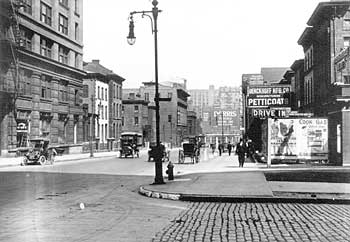
Southeast corner of Locust (formerly Lucas Place) and 15th streets, circa 1920.
© Campbell House Foundation 2004
Lucas Place, with 1st Presbyterian Church on the eastern end and 2nd Presbyterian Church on the western. The first home of Washington University was located not far away, along with Smith Academy, where most residents sent their sons for school. Girls were sent to the Mary Institute, sited next to 1st Presbyterian Church. The St. Louis School and Museum of Fine Arts (now the St. Louis Art Museum) and the Missouri Historical Society (which operates the Missouri History Museum today) both had their first homes on Lucas Place. Directly behind General Harney’s house was the first public high school west of the Mississippi.
The last private residence on Lucas Place was built in 1877. By then, St. Louis had expanded considerably, and Lucas Place was no longer removed from city life. Importantly, younger residents no longer viewed the area as desirable, instead choosing new suburbs further west. In 1883, Missouri Park was replaced with the St. Louis Exposition Hall. As families sold or died off
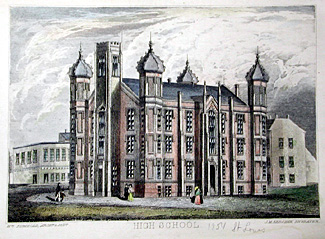
St. Louis’ first public high school was at the corner of 15th and Olive, one block off Lucas Place.
© Campbell House Foundation 2004
and deed restrictions expired, the once-elegant homes were converted into boarding houses. Other houses were torn down and replaced with hotels, parking lots, or places of business. Even the name was changed in the early 1900s to Locust Street.
Today, the Campbell House is all that remains of what Lucas Place once was.


